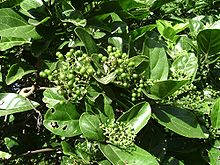
Summary
Premna serratifolia is a small tree/shrub[2] in the family Lamiaceae. It flowers and fruits between May and November.[3] During flowering season, it attracts a large number of butterflies and bees.[4] Synonyms of Premna serratifolia Linn. include P. corymbosa (Burm. f.) Merr., P. integrifolia L. and P. obtusifolia R. Br.).
| Premna serratifolia | |
|---|---|

| |
| Leaves and young fruit | |
| Scientific classification | |
| Kingdom: | Plantae |
| Clade: | Tracheophytes |
| Clade: | Angiosperms |
| Clade: | Eudicots |
| Clade: | Asterids |
| Order: | Lamiales |
| Family: | Lamiaceae |
| Genus: | Premna |
| Species: | P. serratifolia
|
| Binomial name | |
| Premna serratifolia | |
| Synonyms | |
Habitat edit
It mostly grow in moist sandy soil and scrub jungles along seacoasts and mangrove forests.[3] In the Philippines, particularly in Cebu Island, it is usually found in the interior, watery forests of Southern Cebu.
Description edit
Trees, to 7 m high. Leaves simple, opposite, estipulate; petiole 4–14 mm, slender, pubescent, grooved above; lamina 2.5-8.5 x 2–7.2 cm, elliptic, elliptic-oblong, base acute, obtuse, subcordate or rounded, apex acuminate, mucronate, obtuse, margin entire or subserrate, glabrous above except along the appressed midrib, chartaceous; lateral nerves 3-5 pair, pinnate, prominent, puberulous beneath; intercostae reticulate, obscure. Flowers bisexual, greenish-white, in terminal corymbose panicled cymes; bracts small; calyx small campanulate, 2 lipped, 5 lobed; corolla tube short, villous inside, lobes 5; stamens 4, didynamous, inserted below the throat of the corolla tube; anther ovate; ovary superior, 2-4-celled, ovules 4; style linear; stigma shortly bifid. Fruit a drupe, seated on the calyx, globose, purple; seeds oblong.[3]
Medicinal uses edit
The plant is extensively used in Indian traditional medicine. Studies on the root wood of P. serattifolia led to the isolation of acteoside, a glucoside derivative.[5] The root bark of the plant which showed biological activities have also shown to contain a potent cytotoxic and antioxidant diterpene, 11,12,16-trihydroxy-2-oxo-5-methyl-10-demethyl-abieta-1[10],6, 8,11,13-pentene.[6]
Culinary uses edit
In Vietnam, the aromatic leaves of P. serratifolia are called lá cách, and are used to cook in some braise or stir fry dishes with chicken, eels or frogs.[citation needed]
References edit
- ^ Razafiniary, V. (2021). "Premna serratifolia". IUCN Red List of Threatened Species. 2021: e.T66295794A68121996. doi:10.2305/IUCN.UK.2021-1.RLTS.T66295794A68121996.en. Retrieved 20 November 2021.
- ^ Description given by G. Renu, Sanjana Julias Thilakar, D. Narasimhan, Centre for Floristic Research, Department of Botany, Madras Christian College, Tambaram. Referred from indiabiodiversity portal http://indiabiodiversity.org/species/show/230814
- ^ a b c Described by Dr. N Sasidharan (Dr. B P Pal Fellow), Kerala Forest Research Institute, Peechi in India biodiversity portal http://indiabiodiversity.org/species/show/230814
- ^ The media files included gives the required verity.
- ^ Bose LV, Varghese GK, Habtemariam S. 2013. Identification of acteoside as the active antioxidant principle of Premna serratifolia root wood tissues. Phytopharmacology 4: 228–236
- ^ Habtemariam, S., Varghese, G.K. (2015). A Novel Diterpene Skeleton: Identification of a highly aromatic, cytotoxic and antioxidant 5-methyl-10-demethyl-abietane-typediterpene from Premna serratifolia Phytotherapy Research 29(1), 80-85.
Further reading edit
- Flora of Tamil Nadu, VOL. II, 1987
- Premna serratifolia L., Mant. Pl. 2: 253. 1771; Gamble, Fl. Pres. Madras 1096(767). 1924; Ramach. & V.J. Nair, Fl. Cannanore Dist. 357. 1988; Antony, Syst. Stud. Fl. Kottayam Dist. 318. 1989; Rajendran & Daniel, Indian Verbenaceae 284. 2002.
- Premna integrifolia L., Mant. Pl. 2: 252. 1771, nom. illeg.; Hook. f., Fl. Brit. India 4: 574. 1885.
- Premna obtusifolia R. Br., Prodr. 512. 1810; Manilal & Sivar., Fl. Calicut 230. 1982; Ansari, Fl. Kasaragod Div. 296. 1985



